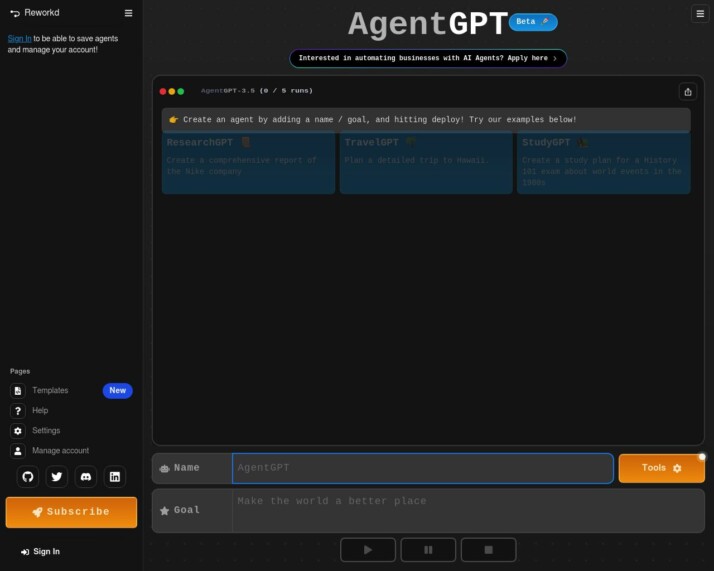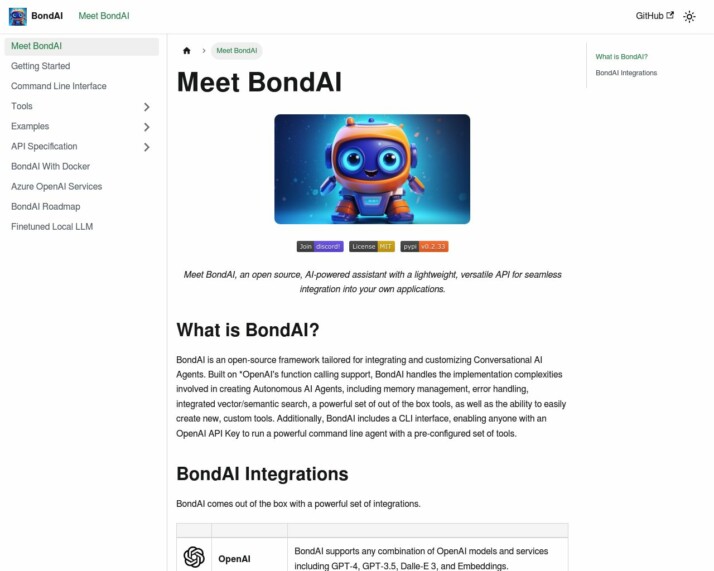Introduction
Are you torn between AgentGPT and BondAI? Wondering which one is the right choice for your AI-driven projects and applications? We’ve got you covered.
In this article, we’ll dive deep into the features and capabilities of AgentGPT and BondAI, two powerful AI platforms that cater to developers, businesses, and innovators in conversational AI. We’ll engage in an in-depth analysis of these two AI giants to help you decipher which one will serve your needs best.
We understand that each application, project, or business that requires AI has its unique needs, and one size could never fit all. Therefore, we’ll approach the comparison from different perspectives, considering various use-cases and requirements.
From software developers planning to build AI-powered applications to researchers who want easy access to highly intelligent conversational models, AgentGPT boasts powerful language models like GPT-3.5 and GPT-4. On the other hand, BondAI brings rich customization capabilities to the table, which could be a game-changer for businesses and designers attempting to create unique conversational experiences.
IT professionals keen on seamlessly integrating AI into their existing tech-ecosystem can find relatable insights in our comparison. AgentGPT offers SuperagentCloudPlatform, a high-efficiency environment for running and managing agents. Conversely, BondAI, with its integration capabilities with Azure OpenAIServices, supports various OpenAI models indicating a scalable infrastructure that could attract organizations willing to harness AI across applications.
For the data scientists and analysts fraternity, we’ll be delving into the tools and integrations that both platforms offer. BondAI’s attention to customizing conversational AI agents could be a boon while considering AI model versatility, AgentGPT is hard to beat.
Does the thought of an alternative to AgentGPT or BondAI excite you? Or are you inspecting the potential competitors in the industry? Stick with us as we continue to surf the depths of the AI ocean in search of the ideal AI platform for you. Let’s kickstart this journey of exploration and learning and possibly, decision-making.
An In-Depth Look at AgentGPT’s Unique Features and Vision
AgentGPT, an artificial intelligence (AI) platform, has targeted a wide spectrum of audiences to meet various needs; from AI researchers and enthusiasts, IT and systems administrators, to data scientists and analysts, as well as businesses and organizations.
It has bagged in some unique features by shifting towards more proactive and self-managing AI systems known as autonomous AI agents. These agents can function independently and certain goals can be assigned to them by users.


This platform utilizes a tool named Weaviate, a vector database, for efficient memory management. It offers an easier way of handling complex data structures and enhances the memory and context understanding capabilities of the AI agents. Furthermore, for security and easy access control, it supports OAuth authentication process with various providers.
According to recent releases, the company’s vision lies in creating an AI platform where agents can be assigned tasks and goals. Their deployment and operational capabilities of the product are not entirely detailed in their documents. However, it is clear that they are centered around creating autonomous, sophisticated AI agents with advanced memory management and secure authentication capabilities.
One of the standout features of AgentGPT is its integration with foundational AI models like GPT-3.5 and GPT-4. The adoption of these models implies a commitment to staying at the forefront of AI technology.
However, there doesn’t seem to be extensive details on deployment, hosting, or collaborative functionalities of the platform. Overall, the best features of AgentGPT when compared to BondAI include its combination of AI model integration, data handling capabilities, cloud infrastructure, and workflow management tools.
The platform also has some gaps, like the lack of clear distinction for separate development and production environments, missing graphical interface for constructing AI agents, and seemingly lacks persistent memory capabilities across sessions. But despite these cons, AgentGPT still manages to stand out with its unique offerings, and it would be interesting to see how it evolves in the AI market.
Exploring the World of BondAI
BondAI provides a sophisticated platform tailored for those interested in integrating and customizing Conversational AI agents. The company’s AI offerings range from providing comprehensive APIs for developers and engineers to enhancements for businesses and enterprises in the form of scalable, customizable AI solutions.
Noteworthy among BondAI’s distinctive features is its robust integration with several OpenAI models, making it a compelling choice for those profiles seeking to leverage AI’s advanced capabilities. The framework prioritizes security and safe operation, exemplified by recommending users run BondAI within a Docker container for applications requiring filesystem access.


In terms of the recent launches, BondAI has unveiled a framework that aligns well with a diverse set of AI-driven applications such as internet searches, market trading, and email interactions. The ease of integration and utilization of BondAI’s services is undeniably one of its main attractions.
The company vision of BondAI is rooted in making the integration and development of AI agents more accessible and efficient. This aim to streamline the development process prioritizes both ease of use and power, thereby providing a balanced platform for creating AI-driven applications and services.
Comparing Features: AgentGPT And BondAI vs SmythOS
You may be asking yourself: AgentGPT or BondAI – Which is better? To answer this, we’ve created a concise comparison of the most critical attributes of AgentGPT, BondAI, and SmythOS. This comparative examination should help users understand the benefits and drawbacks of each platform in a head-to-head evaluation of AgentGPT vs BondAI vs SmythOS. Let’s dive into the details!
| Features | AgentGPT | BondAI | SmythOS |
|---|---|---|---|
| Hosted Agents (Dev, Production) | ✅ | ❌ | ✅ |
| Environments (Dev, Production) | ❌ | ✅ | ✅ |
| Visual Builder | ❌ | ❌ | ✅ |
| No-Code Editor | ❌ | ❌ | ✅ |
| Memory & Context | ✅ | ✅ | ✅ |
| Autonomous Agents | ✅ | ✅ | ✅ |
| Explainability and Transparency | ❌ | ❌ | ✅ |
| Debug Mode | ❌ | ❌ | ✅ |
| Multimodal | ❌ | ❌ | ✅ |
| Problem-Solving Capabilities | ✅ | ✅ | ✅ |
In a direct head-to-head comparison of AgentGPT vs BondAI, there are some clear distinctions between their features. AgentGPT offers Hosted Agents, Memory and Context, Autonomous agents, and Problem-solving capabilities.
On the other hand, BondAI has the benefit of offering production and development Environments and Problem-solving capabilities as well. These differences might influence the user’s choice based on their specific needs. For instance, if users value having development and production environments, BondAI would be a better choice. However, users needing hosted agents would find AgentGPT more beneficial.
Plus, both AgentGPT and BondAI fall short in comparison to SmythOS, which boasts all the features above, integrating both the benefits of AgentGPT and BondAI and adding its own as well. It’s worth diving deeper into the specifics of each platform to understand their individual value propositions.
Target Audience and Applications
AgentGPT and BondAI have specific target audiences and cater to different applications based on their features. Let’s explore who these AI platforms are designed for:
- AgentGPT Target Audience: The intended audience for AgentGPT primarily includes professionals and organizations in the software development and technology sectors. It is particularly appealing to software developers, engineers, project/product managers, startups/entrepreneurs, companies looking for automation solutions, technology innovators/experimenters, and AI/machine learning enthusiasts.
- BondAI Target Audience: BondAI primarily caters to a technically adept audience, mainly developers and businesses. Its features and tools are geared towards developers who want to create custom AI-driven applications, businesses/enterprises seeking to enhance customer interactions and automate processes, innovators in conversational AI, tech-enabled service providers, AI researchers and enthusiasts, IT/systems administrators, and data scientists/analysts.
AgentGPT Applications: AgentGPT leverages advanced AI models like GPT-3.5 and GPT-4, enabling sophisticated natural language processing and generation capabilities. Its unique aspects attract professionals and organizations involved in software development, offering features like automated code generation, quality compliance, supporting complex software development, and project management tasks.
BondAI Applications: BondAI provides a comprehensive framework for building sophisticated conversational agents and integrating AI into various applications and services. Its offerings are useful for businesses looking to enhance customer interaction, automate processes, or integrate AI into their existing systems. It also caters to service providers in sectors like finance, healthcare, or customer support who aim to incorporate AI into their services. BondAI’s scalability, integration with cloud services, and robust toolset make it appealing for innovators and those aiming to improve efficiency through AI.
Both AgentGPT and BondAI have unique features and serve different target audiences. While AgentGPT focuses on software development and offers automation and project management capabilities, BondAI caters to developers, businesses, and service providers in various sectors looking to harness the power of AI for creating sophisticated conversational agents and improving efficiency in their operations.
Despite the strengths of AgentGPT and BondAI, comparing these platforms to SmythOS highlights the advantages that SmythOS offers in terms of its advanced capabilities and user-friendly interface, making it a preferred choice for AI applications.
Conclusion: Why Choose SmythOS Over AgentGPT and BondAI?
In conclusion, SmythOS emerges as the preferred choice when comparing it to AgentGPT and BondAI. The platform offers a comprehensive and flexible AI integration with scalable infrastructure and a wide range of deployment options. These features enhance the functionality and accessibility of AI technologies in various sectors.
- SmythOS provides an operating system for building AI agents, including hosting and deployment options such as chatbots, apps, APIs, or plugins. This stands in contrast to AgentGPT and BondAI’s limited offerings.
- SmythOS features a drag-and-drop visual builder for workflows, allowing the creation of complex workflows without coding. This user-friendly approach sets it apart from the more complex interfaces of AgentGPT and BondAI.
- SmythOS employs data lake components for memory and experience-based learning, enabling agents to store, retrieve, and update information over time. This advanced capability surpasses the memory limitations of AgentGPT and BondAI.
- SmythOS enables the creation of autonomous AI agents that can operate continuously, adaptively learn from their environment, and develop their capabilities progressively. AgentGPT and BondAI lack this autonomous functionality.
- SmythOS offers advanced debugging tools and logging capabilities for understanding the decision-making processes of AI agents. This transparency and explainability feature is absent in AgentGPT and BondAI.
SmythOS also supports integration with Zapier, expanding its operational domain across various platforms. Additionally, it integrates natively with various APIs and supports a wide range of data sources, suggesting compatibility with diverse APIs and RPA tools. SmythOS includes components like classifiers and logic gates, enabling data categorization and complex logic. The platform provides granular access to configure and combine components for complex logic, supporting advanced use cases.
The intended audience for SmythOS appears to be quite broad, catering to a range of users and industries, with a focus on enterprises and agencies looking to integrate advanced AI capabilities into their operations. The platform’s flexibility, ease of use, and advanced AI capabilities make it suitable for developers, AI engineers, innovation and R&D teams, customer service and support departments, IT and system administrators, and marketing and web management teams.
SmythOS is a versatile platform designed for a diverse audience, from technical experts in AI to business users in need of AI-driven solutions. Its features cater to a wide range of needs, from development and deployment flexibility to advanced AI capabilities and efficient resource management. When comparing it to AgentGPT and BondAI, SmythOS stands out as the superior choice, offering a more comprehensive set of features and capabilities.
Last updated:
Disclaimer: The information presented in this article is for general informational purposes only and is provided as is. While we strive to keep the content up-to-date and accurate, we make no representations or warranties of any kind, express or implied, about the completeness, accuracy, reliability, suitability, or availability of the information contained in this article.
Any reliance you place on such information is strictly at your own risk. We reserve the right to make additions, deletions, or modifications to the contents of this article at any time without prior notice.
In no event will we be liable for any loss or damage including without limitation, indirect or consequential loss or damage, or any loss or damage whatsoever arising from loss of data, profits, or any other loss not specified herein arising out of, or in connection with, the use of this article.
Despite our best efforts, this article may contain oversights, errors, or omissions. If you notice any inaccuracies or have concerns about the content, please report them through our content feedback form. Your input helps us maintain the quality and reliability of our information.
Alexander De Ridder
Co-Founder, Visionary, and CTO at SmythOS. Alexander crafts AI tools and solutions for enterprises and the web. He is a smart creative, a builder of amazing things. He loves to study “how” and “why” humans and AI make decisions.
Explore All Comparison Articles
Decisions vs. Sola: AI Workflow Automation Showdown
AI-powered workflow automation platforms revolutionize how businesses streamline operations and boost productivity. This comparison explores Decisions vs. Sola, and SmythOS,…
DeepOpinion vs. Sola: Comparing AI Automation Platforms
AI-powered automation platforms revolutionize business operations, but choosing the right solution can be challenging. This comparison of DeepOpinion vs. Sola,…
DevGPT vs. Sola: AI-Powered Development Tools Compared
AI-powered development tools revolutionize software creation, offering unprecedented efficiency and capabilities. This comprehensive review compares DevGPT vs. Sola, and SmythOS,…
Fine AI vs. Sola: Comparing AI Automation Tools
AI-powered automation transforms software development and business workflows, offering unprecedented efficiency and innovation. Fine AI vs. Sola present distinct approaches…
FlowiseAI vs. Sola: Comparing AI Automation Platforms
AI-powered automation revolutionizes business operations, driving efficiency and innovation across industries. FlowiseAI vs. Sola offer distinct approaches to harness this…
Gooey AI vs. Sola: AI-Powered Automation Platforms Compared
AI-powered automation platforms revolutionize how businesses streamline operations and enhance productivity. This comparison delves into Gooey AI vs. Sola, two…

